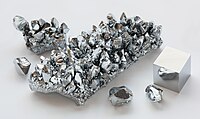
Photo from wikipedia
Abstract Tannery sludge, produced during the treatment of tanning effluents, is considered as hazardous waste, since it contains significant amounts of leachable Cr(III) and organic matter, according to the respective… Click to show full abstract
Abstract Tannery sludge, produced during the treatment of tanning effluents, is considered as hazardous waste, since it contains significant amounts of leachable Cr(III) and organic matter, according to the respective legislation. Following the EU general environmental protection guidelines, both chromium and energy recovery are strongly recommended, by applying the principles of circular economy and for improving sustainability. Therefore, this research aims to investigate the relevant major mechanisms during the respective resources’ recovery process. In the present study, a limited heating value of dried sludge was measured, namely 2 MJ/Kg, which however can be considered as sufficient to be recovered, when using the appropriate incinerator. After combustion, 50% weight loss was found, while almost half of the initial Cr(III) content was oxidized to Cr(VI). Furthermore, by applying a relatively simple hydrometallurgical leaching procedure to the corresponding ash by-product (by the addition of 1 N H2SO4 solution), rather limited leaching efficiency was found (57%), despite the presence of extremely soluble Cr(VI); this was attributed to the sparkly soluble Cr2O3 formation. Instead, since the chromium initially dominant form was Cr(OH)3 (i.e. soluble in acidic media), up to 93% of Cr(III) content was leached. Additionally, the higher efficiency of H2SO4 as leaching agent, among the different examined acids, was accompanied with an increase in selectivity towards the other co-existing major components (mainly Ca).
Journal Title: Journal of Environmental Chemical Engineering
Year Published: 2019
Link to full text (if available)
Share on Social Media: Sign Up to like & get
recommendations!